

Gin - GIN (GWT INjection) is Guice for Google Web Toolkit client-side code. GWT Development with Activities and Places - Google Web Toolkit. GWT 2.1 introduced a built-in framework for browser history management.
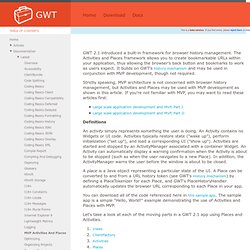
The Activities and Places framework allows you to create bookmarkable URLs within your application, thus allowing the browser's back button and bookmarks to work as users expect. It builds on GWT's history mechanism and may be used in conjunction with MVP development, though not required. Strictly speaking, MVP architecture is not concerned with browser history management, but Activities and Places may be used with MVP development as shown in this article. If you're not familiar with MVP, you may want to read these articles first: Definitions An activity simply represents something the user is doing. A place is a Java object representing a particular state of the UI.
You can download all of the code referenced here in this sample app. Guice - Guice (pronounced 'juice') is a lightweight dependency injection framework for Java 5 and above, brought to you by Google. Google Guice. Google Guice (pronounced "juice")[1] is an open source software framework for the Java platform released by Google under the Apache License.
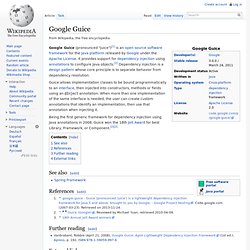
It provides support for dependency injection using annotations to configure Java objects.[2] Dependency injection is a design pattern whose core principle is to separate behavior from dependency resolution. Guice allows implementation classes to be bound programmatically to an interface, then injected into constructors, methods or fields using an @Inject annotation. When more than one implementation of the same interface is needed, the user can create custom annotations that identify an implementation, then use that annotation when injecting it.
Being the first generic framework for dependency injection using Java annotations in 2008, Guice won the 18th Jolt Award for best Library, Framework, or Component.[2][3] See also[edit] ARIA For GWT: My health Is feeling accessible. By T.V.
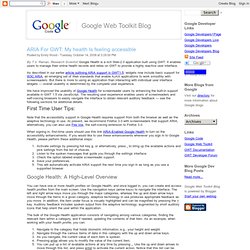
Raman, Research Scientist Google Health is a rich Web-2.0 application built using GWT. It enables users to manage their online health records and relies on GWT to provide a highly reactive user interface. As described in our earlier article outlining ARIA support in GWT1.5, widgets now include basic support for W3C ARIA, an emerging set of Web standards that enable AJAX applications to work smoothly with screenreaders. The History and Future of GWT. GWT 2.5 et plus si affinités : Mistra Blog. Hosted Libraries - Developer's Guide - Make the Web Faster.
GWT Wrappers. Google Web Toolkit. Smartgwt - Smart GWT - GWT API's for SmartClient. Gwt-ext - GWT-Ext Widget Library. Smart GWT Product Overview. Large scale application development and MVP - Google Web Toolkit. Chris Ramsdale, Google Developer Relations Updated March 2010 Also see Part II of this article.
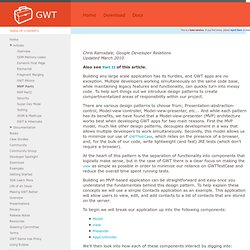
Building any large scale application has its hurdles, and GWT apps are no exception. Multiple developers working simultaneously on the same code base, while maintaining legacy features and functionality, can quickly turn into messy code. To help sort things out we introduce design patterns to create compartmentalized areas of responsibility within our project. There are various design patterns to choose from; Presentation-abstraction-control, Model-view-controller, Model-view-presenter, etc... At the heart of this pattern is the separation of functionality into components that logically make sense, but in the case of GWT there is a clear focus on making the view as simple as possible in order to minimize our reliance on GWTTestCase and reduce the overall time spent running tests.
To begin we will break our application up into the following components: Google Plugin for Eclipse. GWT Designer User Guide - Google Web Toolkit. Getting Started with Speed Tracer - Google Web Toolkit. Google Web Toolkit. GWT emphasizes reusable, efficient[dubious ] approaches to common web development tasks, namely asynchronous remote procedure calls, history management, bookmarking, UI abstraction, internationalization, and cross-browser portability.
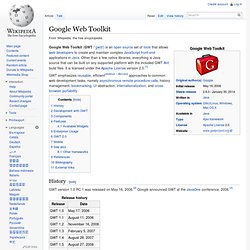
Jslibs - standalone JavaScript development runtime environment with general purpose native libraries. Project Hosting. JavaFX. Before version 2.0 of JavaFX, developers used a statically typed, declarative language called JavaFX Script to build JavaFX applications.
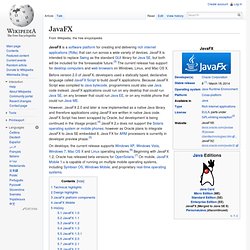
Because JavaFX Script was compiled to Java bytecode, programmers could also use Java code instead. JavaFX applications could run on any desktop that could run Java SE, on any browser that could run Java EE, or on any mobile phone that could run Java ME. On desktops, the current release supports Windows XP, Windows Vista, Windows 7, Mac OS X and Linux operating systems.[6] Beginning with JavaFX 1.2, Oracle has released beta versions for OpenSolaris.[7] On mobile, JavaFX Mobile 1.x is capable of running on multiple mobile operating systems, including Symbian OS, Windows Mobile, and proprietary real-time operating systems. Technical highlights[edit] Coding Basics - JavaScript Native Interface (JSNI) - Google Web Toolkit. Often, you will need to integrate GWT with existing handwritten JavaScript or with a third-party JavaScript library.
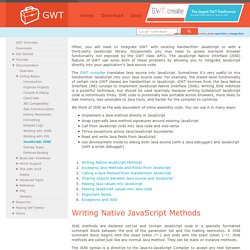
Occasionally you may need to access low-level browser functionality not exposed by the GWT class API's. Jsni - JavaScript Native Interface. PROJECT HAS MOVED TO: jsni is now a module of the Jslibs project and has been renamed jsffi (JavaScript Foreign Function Interface). see JSNI for JavaScript Native Interface is a project that will allow you to call any symbol in a native module (dll/so).

This project is a simple file that you can link with any spidermonkey embedding project. Example: function MyAlert( text, caption ) { var ret = new NativeData; ret.PU32.Alloc(); new NativeModule( 'C:\\WINDOWS\\SYSTEM32\\User32').Proc('MessageBoxA')( ret.PU32, DWORD( 0 ), SZ(text), SZ( caption || 'Alert' ), DWORD( 1 ) ); return ret.PU32[0];} Developer's Guide - Logging - Google Web Toolkit. This document is for developers interested in logging client-side code in their GWT applications.

Logging is the process of recording events in an application to provide an audit trail to understand how the application executes and to diagnose problems. Logging makes it easier to troubleshoot issues encountered by developers and users. The following sections walk through a logging example application and introduce the basic functionality of the Logging framework and configuration options. Developers should already be familiar with developing a GWT application. Overview of the Logging Framework The logging framework emulates java.util.logging, so it uses the same syntax and has the same behavior as server-side logging code. GWTTestCase. Reports an exception that might have escaped to the browser.
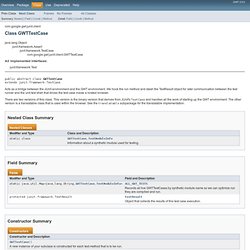
This method is called by the test framework to report uncaught exceptions. The default implementation causes the test case to be reported as 'failed'. However in some rare situations where an uncaught exception is expected, a test case may choose to alter the behavior by overriding it: Note that this method will not cause the test case to fail immediately if the main test body is still executing.
In that case, test will fail after the main body returns with the reported exception. Closure Tools. What is the Closure Compiler? The Closure Compiler is a tool for making JavaScript download and run faster. Instead of compiling from a source language to machine code, it compiles from JavaScript to better JavaScript. It parses your JavaScript, analyzes it, removes dead code and rewrites and minimizes what's left.
It also checks syntax, variable references, and types, and warns about common JavaScript pitfalls. How can I use the Closure Compiler? You can use the Closure Compiler as: An open source Java application that you can run from the command line. To get started with the compiler, see "How do I start" below. What are the benefits of using Closure Compiler?
Efficiency. Html5shiv - HTML5 IE enabling script.